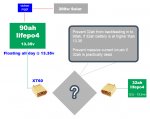hour
Observer
Hopefully my diagram explains what I can't manage to do without producing a wall of text (it still happened).
I was going to be paralleling a low state of charge 18ah aux battery to a 200ah(2x6v) golf cart battery floating at full charge, both lead acid, and that apparently was okay since the resistance of the 18ah battery would prevent some enormous current transfer. With lithium, I do not know.
What I do know is that my 90ah lifepo4 house battery is going to be kept at like 13.3-13.35v and be full most of the day, and I'd like to connect a potentially near-dead 32ah lifepo4 battery to it. Alternately, I might charge the 32ah inside to a higher voltage than the house battery, set up camp, and put in parallel.
I'm aware that in this approach the 32ah battery will never reach a higher voltage than the house battery, as regulated by its solar charge controller, and that's okay. If I can bring a dead 32ah battery up to 13.35v I'll be happy. I just don't want to have 10 gauge wire maxing itself out when a flat battery is connected to a full one, nor do I really want to have a 13.5v 32ah battery trying to equalize with a 13.35v 90ah battery.. though that outcome wouldn't bother me as long as its safe. The 32ah does have a 100a BMS, but even if it's grossly overrated by chinese mfg specs I still don't want anywhere near 50a charge going in to it.
Would a DROK step up/boost 5-amp converter work for this? Input voltage 13.35, output 13.36 (or anything slightly higher, whatever it lets me), and be current limited to 5 amps? Or will the dead 32ah try to suck a ton the second they're paralleled and blow the DROK?
Thanks for ideas, part suggestions, anything!
I was going to be paralleling a low state of charge 18ah aux battery to a 200ah(2x6v) golf cart battery floating at full charge, both lead acid, and that apparently was okay since the resistance of the 18ah battery would prevent some enormous current transfer. With lithium, I do not know.
What I do know is that my 90ah lifepo4 house battery is going to be kept at like 13.3-13.35v and be full most of the day, and I'd like to connect a potentially near-dead 32ah lifepo4 battery to it. Alternately, I might charge the 32ah inside to a higher voltage than the house battery, set up camp, and put in parallel.
I'm aware that in this approach the 32ah battery will never reach a higher voltage than the house battery, as regulated by its solar charge controller, and that's okay. If I can bring a dead 32ah battery up to 13.35v I'll be happy. I just don't want to have 10 gauge wire maxing itself out when a flat battery is connected to a full one, nor do I really want to have a 13.5v 32ah battery trying to equalize with a 13.35v 90ah battery.. though that outcome wouldn't bother me as long as its safe. The 32ah does have a 100a BMS, but even if it's grossly overrated by chinese mfg specs I still don't want anywhere near 50a charge going in to it.
Would a DROK step up/boost 5-amp converter work for this? Input voltage 13.35, output 13.36 (or anything slightly higher, whatever it lets me), and be current limited to 5 amps? Or will the dead 32ah try to suck a ton the second they're paralleled and blow the DROK?
Thanks for ideas, part suggestions, anything!
Attachments
Last edited:

